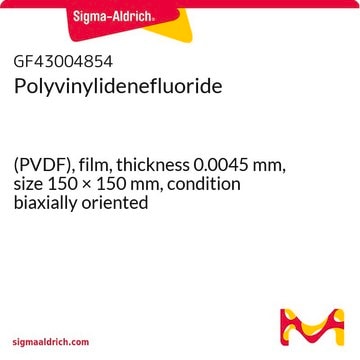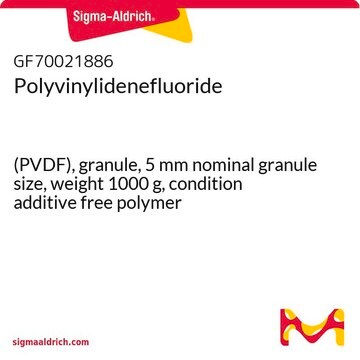182702
Poly(vinylidene fluoride)
average Mw ~534,000 by GPC, powder
Sinonimo/i:
PVDF
About This Item
Prodotti consigliati
Tensione di vapore
15 mmHg ( 32 °C)
Forma fisica
powder
PM
average Mw ~534,000 by GPC
Indice di rifrazione
n20/D 1.42
Temp. transizione
Tg −38 °C
Tm 171 °C
Densità
1.74 g/mL at 25 °C
Stringa SMILE
FC(F)=C
InChI
1S/C2H2F2/c1-2(3)4/h1H2
BQCIDUSAKPWEOX-UHFFFAOYSA-N
Cerchi prodotti simili? Visita Guida al confronto tra prodotti
Categorie correlate
Descrizione generale
Applicazioni
Codice della classe di stoccaggio
11 - Combustible Solids
Classe di pericolosità dell'acqua (WGK)
WGK 3
Punto d’infiammabilità (°F)
Not applicable
Punto d’infiammabilità (°C)
Not applicable
Dispositivi di protezione individuale
Eyeshields, Gloves, type N95 (US)
Certificati d'analisi (COA)
Cerca il Certificati d'analisi (COA) digitando il numero di lotto/batch corrispondente. I numeri di lotto o di batch sono stampati sull'etichetta dei prodotti dopo la parola ‘Lotto’ o ‘Batch’.
Possiedi già questo prodotto?
I documenti relativi ai prodotti acquistati recentemente sono disponibili nell’Archivio dei documenti.
I clienti hanno visto anche
Il team dei nostri ricercatori vanta grande esperienza in tutte le aree della ricerca quali Life Science, scienza dei materiali, sintesi chimica, cromatografia, discipline analitiche, ecc..
Contatta l'Assistenza Tecnica.






